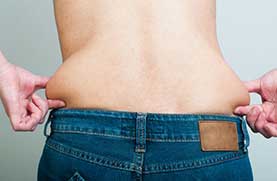Slimming Patches – Can You Lose Weight
 Scientists in Singapore have developed a skin patch that has the potential to help people to lose weight by causing white body fat to become brown body fat. If you didn’t know there were two types of body fat, don’t worry. Most people don’t.
Scientists in Singapore have developed a skin patch that has the potential to help people to lose weight by causing white body fat to become brown body fat. If you didn’t know there were two types of body fat, don’t worry. Most people don’t.
White fat is the type of fat that is formed when the body receives too many calories, and its presence around the belly area brings with it an increased risk of cardiovascular disease and cancer. Brown fat is a calorie burning fat, so it often called “good fat”, but the bad thing is most of use are not carrying much of it around.
The idea of converting white fat to brown fat has fascinated scientists for a long time and tests conducted on laboratory mice suggest researchers at Nanyang Technological University may have finally made the dream a reality.
They have achieved this by developing a special skin patch that contains hundreds of micro-needles that become embedded in the skin and penetrate the white fat tissue. As the micro-needles degrade they release drugs that cause the white fat to start turning brown.
Click here to read about the Slim Diet Patch – Australia’s favourite slimming patch
 When the researchers tested the patch on mice that were being fed a high fat diet, they found it suppressed weight gain and reduced fat mass by more than 30%.
When the researchers tested the patch on mice that were being fed a high fat diet, they found it suppressed weight gain and reduced fat mass by more than 30%.
Does this mean a new mini-needle slimming patch is likely to become available soon? Unfortunately not. The patches have never been tested on humans. The only thing that is certain is they appear to work for mice.
News about new slimming patches always grabs a lot of attention because people like the idea of a weight loss product that can be applied to the skin and then left to get on with its work. It’s quick and easy and, in today’s increasingly hectic world, a no fuss option like that has a lot of appeal.
However, it’s hard to understand why the researchers chose to use such an invasive type of patch technology. The idea of 100s of micro-needles degrading in their flesh could put a lot of people off and there does not appear to be a good reason to go this route.
 Slimming patches normally deliver their ingredients via a process called skin absorption. It’s the same process that nicotine replacement patches employ. Even the morphine patches doctors sometimes prescribe for extreme pain relief deliver the drug to the body via skin absorption and it’s a very effective way to do so.
Slimming patches normally deliver their ingredients via a process called skin absorption. It’s the same process that nicotine replacement patches employ. Even the morphine patches doctors sometimes prescribe for extreme pain relief deliver the drug to the body via skin absorption and it’s a very effective way to do so.
Skin absorption can be a particularly good delivery technique for weight loss formulas because the active ingredients are absorbed into the body over a prolonged period of time and can retain over 90% of their potency. It’s a different matter entirely with diet pills. When pills are swallowed the active ingredients are subjected to harsh digestive enzymes that can rob them off their power and two or more doses are required every day.
The fact that slimming patches are becoming so popular is probably only partly due to how efficient and effective they are, people are also attracted to them because they are so easy to use.
There’s no need to time their use to within so many minutes of a meal or take them at certain time, slimming patches are “plug and play” weight loss supplement.
All you have to do is apply them to a clean area of skin and you are good to go. They are also a perfect choice for anyone who finds it difficult to swallow pills.
The main reason the scientists Nanyang Technological University decided to develop their multi-needle patch was because they needed a better delivery system.
Previous studies, involving a thyroid hormone (T3 triiodothyronine) and a Beta-3 adrenergic receptor agonist had shown it was possible to get white fat to turn brown, but potentially serious side effects were possible when they were consumed in pill form.
Patch technology made it possible to get good results using lower doses and there were no side effects. Multi-needle patch technology is unlikely to be more efficient than skin delivery patches, though, and will almost certainly prove to be more expensive.
The researchers estimate the cost of producing a single patch would be $2.60. Patches that utilize skin absorption can be produced much cheaper that this and the elevated costs involved with producing a patch full of needles are bound to be passed on to the consumer.
